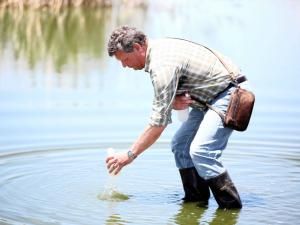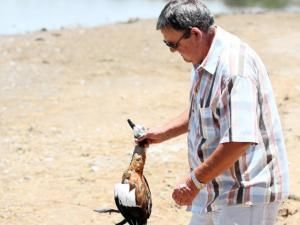Experts have warned that there could be a massive wipe-out of birdlife, as well as a serious threat to residents in Kimberley, as avian botulism is being suggested as the most likely cause of the deaths of more than a thousand water birds at Kamfers Dam.
A water analysis expert from the Free State, Doctor Jan Roos, together with the Provincial State Veterinarian, Doctor Mcdonald Gayakaya and Kamfers Dam farm owner, Herbert Booth, inspected the dam and found hundreds of dead or dying geese, ducks and flamingos scattered on the banks or in shallow water.

© Danie Van der LithDoctor Jan Roos taking water samples from Kamfers Dam.
Roos was called in to collect water samples by Birdlife South Africa and the Save the Flamingo Association, and to do an analysis of the dam's water quality, while Gayakaya collected some of the dying birds to determine the cause of death.
The dying birds started appearing three weeks ago, according to Booth, who owns the farm on which the dam is situated.
Roos, who has done various tests at Kamfers Dam in the past, yesterday said he suspected that the birds had died from avian botulism, as they all displayed the same symptoms of paralysis.
Avian botulism is paralytic disease caused by ingestion of a toxin produced by the bacteria, Clostridium botulinum. This bacteria is widespread in soil and requires warm temperatures, a rich protein source and an anaerobic (no oxygen) environment in order to become active and produce toxins.
"Decomposing vegetation and invertebrates combined with warm temperatures can provide ideal conditions for the botulism bacteria to activate and produce toxins."

© Danie Van der LithHerbert Booth with one of the still barely alive ducks.
Gayakaya added that the birds with botulism would die of starvation, as they could not move their bodies or wings to eat or drink. He took samples of various birds that were paralysed, but still alive, as he said these samples would ensure more accurate blood tests.
It is expected to take about a week to determine if there is botulism toxin in the birds. If the tests are positive, there could be a massive amount of deaths of water birds at Kamfers Dam if urgent measures are not put in place to reduce further exposure to the toxin.
"A botulism outbreak is extremely difficult to control. Carcasses of dead birds will have to be collected to reduce exposure to other birds and scavengers. The inflow from the Homevale Waste Water Treatment Works will also have to be monitored to ensure the radical reduction of organic matter flowing into the dam.
"There is an anti-toxin available, but it is very expensive and difficult to administer to infected birds," Gayakaya said.
ResponsibilityHe further said that once the tests were conducted it would be the responsibility of the Sol Plaatje Municipality and the Northern Cape Department of Nature Conservation and Environmental Affairs to take control of the implementation of corrective measures.
He added that the botulism toxin was one of the most dangerous toxins known to man and that one litre was enough to kill a city the size of New York City.
He said although indirect exposure to humans did not pose a threat, the ingestion of the toxin could be lethal to humans. "This could be a problem if people eat the dead birds."
The three men estimated that the number of dead birds had already reached
more than a thousand, judging by the number of carcasses observed and the extent of the dam's shoreline.
Roos indicated that polluted water flowing into the dam from the Homevale Treatments Works weeks ago, could have contributed to the outbreak.
"Sewage water (in untreated water running into the dam), coupled with the high temperatures and little rainfall, make for an optimal breeding environment for botulism. The content of organic matter is just too concentrated. The problem at Kamfers Dam is that there is no outflow.
"This means all the material from the storm drains and sewage lines end up in the dam where it accumulates, without any way of being flushed out," Roos said.
Mark Anderson, CEO of Birdlife South Africa, yesterday said the mortalities were extremely unfortunate. "If the municipality had done more to address the inflow of poor water quality, the negative affects on Kamfers Dam's birds could be prevented."
Sello Matsie, the Sol Plaatje Municipality's spokesman, reacted by saying that R120 million had already been spent on the upgrade of the Homevale Treatment Works to improve the quality of effluent water flowing into the dam.
"This was done under the supervision of the Department of Nature Conservation and Environmental Affairs, after they gave us a pre-directive which even led to a moratorium on development in Kimberley. After the department was satisfied with our progress, we were able to lift that moratorium. Although we are not equipped with the necessary intensive facilities to test for botulism, we have a disaster management system in place, should it be needed," Matsie said.
Despite the potential life-threatening situation at Kamfers Dam, the Department of Nature Conservation and Environmental Affairs again failed to respond to numerous media inquiries. -
Source: Diamond Fields Advertiser
Reader Comments
to our Newsletter